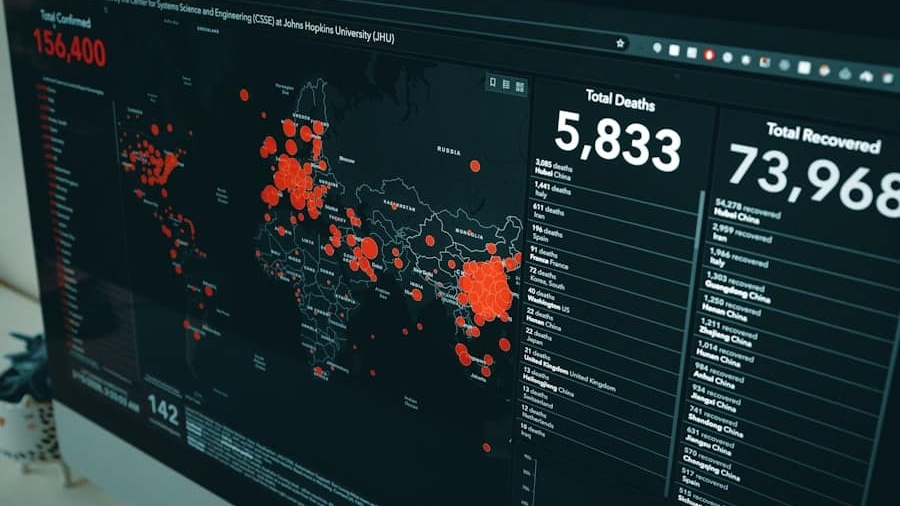The recruitment landscape has undergone a seismic shift in recent years, driven by the advent of artificial intelligence (AI) and big data analytics. These technologies have revolutionized how organizations identify, attract, and retain talent, enabling them to make data-driven decisions that enhance efficiency and effectiveness in hiring processes. AI refers to the simulation of human intelligence in machines programmed to think and learn like humans, while big data encompasses vast volumes of structured and unstructured data that can be analyzed for insights.
Together, they form a powerful toolkit for recruitment professionals seeking to optimize their strategies and outcomes. As organizations grapple with the complexities of a competitive job market, the integration of AI and big data into recruitment analytics has become increasingly essential. Traditional recruitment methods often rely on subjective assessments and manual processes that can be time-consuming and prone to bias.
In contrast, AI-driven tools can analyze vast datasets to identify patterns and trends, allowing recruiters to make informed decisions based on empirical evidence rather than intuition alone. This shift not only enhances the quality of hires but also streamlines the overall recruitment process, making it more agile and responsive to the needs of both employers and candidates.
Key Takeaways
- AI and Big Data are revolutionizing recruitment analytics by providing valuable insights and streamlining processes.
- AI plays a crucial role in automating candidate screening processes, saving time and resources for recruiters.
- Big Data helps in identifying trends in recruitment and talent acquisition, enabling organizations to make data-driven decisions.
- AI and Big Data can be leveraged to enhance diversity and inclusion efforts by removing bias from the recruitment process.
- AI-powered tools improve candidate experience and engagement, leading to a more efficient and personalized recruitment process.
The Role of AI in Streamlining Candidate Screening Processes
Streamlining Candidate Screening with AI
AI plays a pivotal role in transforming candidate screening processes by automating repetitive tasks and enhancing the accuracy of evaluations. One of the most significant applications of AI in recruitment is the use of applicant tracking systems (ATS) that leverage machine learning algorithms to sift through resumes and applications. These systems can quickly identify candidates who meet specific criteria, such as required skills, experience, and educational background, thereby reducing the time spent on manual screening.
Minimizing Human Bias in the Screening Process
Traditional screening methods often inadvertently favor certain demographics or backgrounds, leading to a lack of diversity in hiring. AI algorithms can be designed to focus solely on relevant qualifications and experiences, thereby promoting a more equitable evaluation process. For example, companies like HireVue utilize AI to analyze video interviews, assessing candidates’ responses and body language to provide insights into their suitability for a role.
Matching Candidates with Roles through AI-Driven Assessments
AI can enhance the candidate screening process by providing a more comprehensive understanding of a candidate’s strengths and abilities. For instance, Pymetrics employs neuroscience-based games to assess candidates’ cognitive and emotional traits, allowing employers to match candidates with roles that align with their inherent strengths rather than relying on potentially biased criteria such as educational pedigree or previous job titles.
Leveraging Big Data to Identify Trends in Recruitment and Talent Acquisition
Big data analytics provides recruitment professionals with the ability to uncover valuable insights into hiring trends and talent acquisition strategies.
For instance, data analysis may reveal that certain skills are in high demand within specific industries or geographic regions, enabling recruiters to tailor their outreach efforts accordingly.
Additionally, big data can help organizations assess the effectiveness of their recruitment campaigns by tracking key performance indicators (KPIs) such as time-to-fill, cost-per-hire, and candidate quality. By continuously monitoring these metrics, recruiters can make data-driven adjustments to their strategies, optimizing their approach over time. For example, if data indicates that a particular job posting is attracting a high volume of unqualified applicants, recruiters can refine the job description or adjust the channels through which they promote the position to attract more suitable candidates.
Enhancing Diversity and Inclusion Efforts through AI and Big Data
The integration of AI and big data into recruitment analytics has significant implications for enhancing diversity and inclusion within organizations. By leveraging these technologies, companies can implement more objective hiring practices that reduce bias and promote a diverse workforce. For instance, AI-driven tools can analyze historical hiring data to identify patterns of bias in previous recruitment efforts, allowing organizations to address these issues proactively.
Furthermore, big data can help organizations set measurable diversity goals by providing insights into the demographics of their candidate pools and workforce. By analyzing data on gender, ethnicity, age, and other factors, recruiters can identify gaps in representation and develop targeted initiatives to attract underrepresented groups. For example, companies like Textio use augmented writing technology to analyze job descriptions for biased language that may deter diverse candidates from applying.
By creating more inclusive job postings, organizations can broaden their talent pools and foster a more diverse workplace culture.
Improving Candidate Experience and Engagement with AI-powered Tools
The candidate experience is a critical component of successful recruitment strategies, as it directly impacts an organization’s ability to attract top talent. AI-powered tools can significantly enhance this experience by providing personalized interactions and timely communication throughout the hiring process. Chatbots are one such application; they can engage with candidates in real-time, answering questions about job openings, application statuses, and company culture.
This immediate access to information helps candidates feel valued and informed, ultimately improving their overall experience. Moreover, AI can facilitate a more streamlined application process by enabling one-click applications or pre-filled forms based on candidates’ profiles from platforms like LinkedIn. This convenience reduces friction for candidates who may otherwise be deterred by lengthy application processes.
Additionally, AI-driven feedback mechanisms can provide candidates with insights into their performance during interviews or assessments, fostering a sense of transparency and continuous improvement. Companies like HireVue offer post-interview feedback powered by AI analytics, allowing candidates to understand their strengths and areas for development.
Predictive Analytics and AI in Forecasting Future Talent Needs
Anticipating Workforce Requirements
By analyzing factors such as employee turnover rates, industry growth projections, and skill demand fluctuations, recruiters can anticipate workforce requirements and develop proactive hiring strategies. For instance, if data indicates a rising demand for data scientists within a particular sector, organizations can begin sourcing candidates well in advance to ensure they have access to top talent when needed.
Identifying Skill Gaps
Predictive analytics can help organizations identify potential skill gaps within their existing workforce. By analyzing employee performance data alongside industry trends, companies can determine which skills are becoming increasingly important and invest in training or development programs accordingly.
Enhancing Workforce Readiness and Employee Engagement
This forward-thinking approach not only enhances workforce readiness but also fosters employee engagement by demonstrating a commitment to professional growth.
Overcoming Bias and Discrimination in Recruitment with AI and Big Data
One of the most pressing challenges in recruitment is the presence of bias and discrimination that can influence hiring decisions. AI and big data offer promising solutions for mitigating these issues by providing objective assessments based on quantifiable criteria rather than subjective judgments. For example, algorithms can be trained on diverse datasets that reflect a wide range of backgrounds and experiences, ensuring that hiring decisions are based on merit rather than personal biases.
Moreover, organizations can utilize AI-driven tools to conduct regular audits of their recruitment processes for potential biases. By analyzing hiring patterns across different demographics—such as gender or ethnicity—companies can identify areas where bias may be present and take corrective action. For instance, if data reveals that candidates from certain backgrounds are consistently overlooked during the screening process, organizations can investigate the underlying causes and implement changes to promote fairer evaluations.
The Future of Recruitment Analytics: Opportunities and Challenges with AI and Big Data
As AI and big data continue to evolve, the future of recruitment analytics holds both exciting opportunities and significant challenges for organizations. On one hand, advancements in technology promise to further enhance the efficiency and effectiveness of hiring processes. For example, natural language processing (NLP) capabilities are improving rapidly, enabling AI systems to better understand candidate communications and assess cultural fit more accurately.
However, these advancements also raise ethical considerations regarding privacy and data security. As organizations collect vast amounts of personal information from candidates, they must navigate complex regulations surrounding data protection while ensuring transparency in how this data is used. Additionally, there is an ongoing need for vigilance against algorithmic bias; as AI systems learn from historical data, they may inadvertently perpetuate existing biases if not carefully monitored.
In conclusion, while the integration of AI and big data into recruitment analytics presents transformative opportunities for enhancing hiring practices, it also necessitates a thoughtful approach to ethical considerations and bias mitigation. Organizations that embrace these technologies with a commitment to fairness and transparency will be well-positioned to thrive in an increasingly competitive talent landscape.
If you are interested in utilizing technology to improve various aspects of your life, you may also want to check out this article on the best free software for home remodeling. Just like AI and Big Data are revolutionizing recruitment analytics, these software tools can help streamline and enhance the home renovation process.
FAQs
What is recruitment analytics?
Recruitment analytics is the process of using data and statistical analysis to improve the hiring process. It involves collecting and analyzing data from various sources to make informed decisions about recruiting and hiring.
How is AI improving recruitment analytics?
AI is improving recruitment analytics by automating repetitive tasks, such as resume screening and candidate matching. AI can also analyze large volumes of data to identify patterns and trends, helping recruiters make more informed decisions.
How is big data improving recruitment analytics?
Big data is improving recruitment analytics by providing recruiters with access to a large volume of diverse data sources, such as social media, job boards, and internal databases. This allows recruiters to make more accurate predictions about candidate fit and performance.
What are the benefits of using AI and big data in recruitment analytics?
The benefits of using AI and big data in recruitment analytics include improved efficiency, better candidate matching, reduced bias, and the ability to make data-driven decisions. This can ultimately lead to better hiring outcomes and a more diverse workforce.
What are the potential challenges of using AI and big data in recruitment analytics?
Potential challenges of using AI and big data in recruitment analytics include data privacy concerns, algorithmic bias, and the need for ongoing training and maintenance of AI systems. It’s important for organizations to carefully consider these challenges and implement appropriate safeguards.



